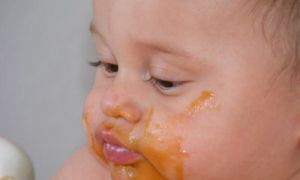As soon as your baby's first tooth emerges and followed by the rest of the teeth, it is important to begin cleaning it – regularly twice a day, morning and at night after the final feed. Most babies “grow” their first tooth at around 4 -6 months of age. Sometimes a tooth can appear without any warning signs at all and sometimes you may notice a small bulge on the gum or a red patch on the gum or cheek, followed in a couple of days by a tooth.
As your child gets older, they will want to become more involved in the tooth brushing process and you should encourage your child to learn how to brush their teeth properly. It is important to remember that your child will not have the necessary skills to do a thorough job of brushing their own teeth so you will need to continue brushing up to the age of five.
How To Brush Baby's Teeth
It is vital you use the right technique when brushing your child's teeth. The aim is to get rid of as much plaque as possible without harming your child's teeth or gums in the process. You need to apply gentle pressure while brushing but too hard can wear away the tooth enamel overtime. So take a little longer but brush less firmly.
Below is a step by step guide to help you get the brushing technique right:
- Start with the outside surfaces of the top teeth, beginning at the back molars, then slowly move around the centre and across to the other side. Hold the brush so that the bristles are at a slight angle to the gum line and move it in a gentle circular motion over one or two teeth at a time.
- Next, clean the inside surfaces of the top teeth, working from the back to the centre and then around to the other side. Hold the brush vertically and use the front section of the brush, again with a gentle circular motion.
- Finally, brush the chewing surfaces. Keep the toothbrush fat so that you can clean the grooves and natural fissures in the molars.
- Repeat for the teeth in the lower jaw.
As well as regular brushing twice a day, one of the most vital things you can do to help keep your child's teeth healthy is to avoid giving your child sugary foods and drinks.
My Child Won't Let Me Brush Their Teeth
At times when it comes to toddler brushing, many toddlers will make tooth brushing a nightmare. Below are some tips that you can use to try and help smooth things along.
- Pretend that you can see food in your child's mouth that needs to be “brushed away”. Praise your child when it's "gone".
- Put a mirror at your child's eye level so they can watch you brush their teeth.
- Brush your own teeth and let your child watch.
- Let your child choose their own “special toothbrush”. They now come in all sorts of colours and even have children's favourite characters on them.
- Always tell your child how clean and shiny their teeth look after you finish brushing them.
- Use a hand puppet as a “friend' to brush your child's teeth with.
- Read books on brushing teeth and going to the dentist.
- Watch videos of your child's favourite character brushing their teeth (search on youtube or Elmo/Barney etc.).
- Learn songs on brushing teeth.
- If your child insists on brushing their own teeth let them, but make sure you watch your child's technique and you may want to re-brush them if your child does it too fast.
Your child's teeth have to last a long time before it is replaced by a permanent tooth (at around 6 years of age). So it is important that you look after them from the beginning. I hope this article provides you with a better understanding on how to brush your child's teeth. Now the next time that you brush your teeth, remember that you also have to brush your baby or toddler's teeth also...let the fun begin.










